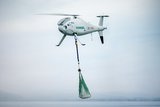Boeing unveils unmanned Phantom Eye demonstrator
The Boeing Company today unveiled the hydrogen-powered Phantom Eye unmanned airborne system, a demonstrator that will stay aloft at 65,000 feet for up to four days.
"Phantom Eye is the first of its kind and could open up a whole new market in collecting data and communications," Darryl Davis, president of Boeing Phantom Works, said today at the unveiling ceremony in St. Louis. "It is a perfect example of turning an idea into a reality. It defines our rapid prototyping efforts and will demonstrate the art-of-the-possible when it comes to persistent intelligence, surveillance and reconnaissance. The capabilities inherent in Phantom Eye's design will offer game-changing opportunities for our military, civil and commercial customers."
Later this summer, Phantom Eye will be shipped to NASA's Dryden Flight Research Center at Edwards Air Force Base, Calif., to begin a series of ground and taxi tests in preparation for its first flight in early 2011. That debut flight is expected to last between four and eight hours.
"The program is moving quickly, and it's exciting to be part of such a unique aircraft," said Drew Mallow, Phantom Eye program manager for Boeing. "The hydrogen propulsion system will be the key to Phantom Eye's success. It is very efficient and offers great fuel economy, and its only byproduct is water, so it's also a 'green' aircraft."
Phantom Eye is powered by two 2.3-liter, four-cylinder engines that provide 150 horsepower each. It has a 150-foot wingspan, will cruise at approximately 150 knots and can carry up to a 450-pound payload.
Key Phantom Eye suppliers and partners include Ford Motor Company (engines); Aurora Flight Sciences (wing); Mahle Powertrain (propulsion controls); Ball Aerospace (fuel tanks); Turbosolutions Engineering (turbochargers); the Defense Advanced Research Projects Agency; and NASA.
Source: Boeing
More from Uncrewed Vehicles
-
Jammer resistant drone designs spark search for countermeasures
The Russia-Ukraine conflict has driven another stage of evolution for drones and the counter measures to defend against them.
-
![L3Harris launches Amorphous software for control of uncrewed platforms]()
L3Harris launches Amorphous software for control of uncrewed platforms
The new Amorphous software is a universal controller that would allow a single operator to control a swarm of “thousands” of uncrewed systems, from drones to underwater platforms.
-
ideaForge unveils new UAVs at Aero India 2025
India UAV supplier ideaForge has launched the Netra 5 and Switch V2 drones at Aero India 2025, boasting of enhanced endurance, AI-driven autonomy and improved operational capabilities.
-
![Shaping the future of defence: What 2025 holds for the global drone market]()
Shaping the future of defence: What 2025 holds for the global drone market
The UAV market is experiencing unprecedented growth, with innovations in technology and battlefield applications driving demand across military sectors. From the battlefields of Ukraine to NATO exercises and beyond, drones are transforming how wars are fought and supported.
-
![Maris-Tech confirms customers signing up for Jupiter Drones codec and AI-powered system]()
Maris-Tech confirms customers signing up for Jupiter Drones codec and AI-powered system
Launched at AUSA in October, the company’s multi-stream video codec is attempting to bring a new lease of life to drone technology through its AI accelerator.
-
![AUSA 2024: Quantum-Systems targets big 2025 with UAS developments]()
AUSA 2024: Quantum-Systems targets big 2025 with UAS developments
Quantum-Systems has been upgrading its UAS family, with new versions of the Vector, Reliant and Twister drones set for release throughout 2025.
























